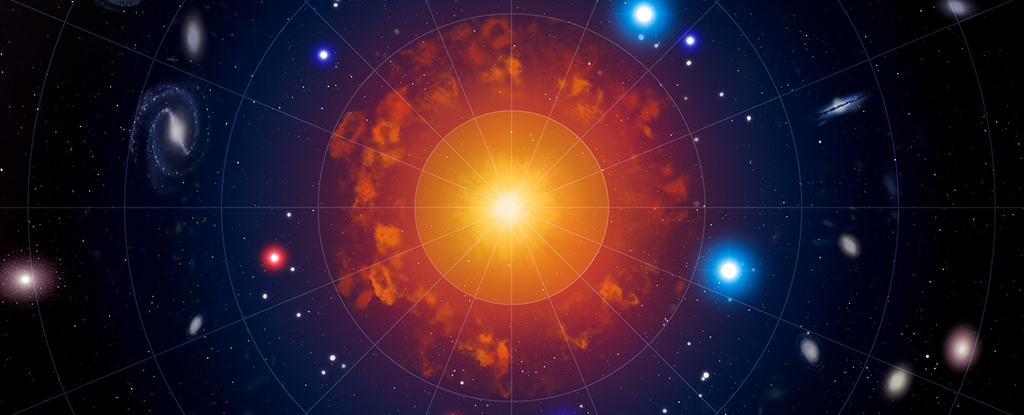An international research team has announced that if dark matter decays by emitting a small amount of light (photons), the lower limit of its lifetime is at least 10^24 seconds (about 3.17 quadrillion years).
These results are based on valuable data obtained from the dwarf galaxies Leo V and Tucana II using cutting-edge near-infrared spectroscopy techniques and precision observations using the 6.5m Magellan Telescope.
Previous theories held that dark matter would never decay, but this observation puts a new lower limit on its lifetime and raises new questions about the role of dark matter in the evolution of the universe and the formation of galaxies.
But if dark matter disappeared in 30 quadrillion years, what would happen to our universe?
Searching for evidence of dark matter decay
The “ordinary matter” that we can see with the naked eye or through conventional telescopes is actually thought to be only a tiny part of the entire universe.
Rather, it appears that the majority of it is made up of ” dark matter ,” an entity that is not directly visible and operates almost behind the scenes.
It has long been believed that dark matter exists, based on the fact that galaxies rotate faster than expected and the way light is bent in a way known as gravitational lensing. However, key aspects of dark matter, such as its mass, interactions, and lifespan, have yet to be elucidated.
In recent years, “Axion-like Particles (ALPs)” have been attracting attention as a promising candidate.
Theory suggests that if ALP is dark matter, it may decay slightly and emit light (photons).
The mass is thought to range widely, from 0.01 eV to a few eV, and one hint is that if light is emitted in this energy band, it can be observed as a “line spectrum” at near-infrared wavelengths.
In fact, about 40 years ago, some people put forward the theory that dark matter has a mass on the eV scale and is generated thermally.
However, to confirm whether particles this light actually exist, spectroscopic observations with high sensitivity and resolution are essential.
Instruments such as the James Webb Space Telescope (JWST) and MUSE are playing an important role in this effort, but in places such as the center of the galaxy, there is too much of a mixture of stars, gas, and background radiation, making it not easy to extract just the light emitted by dark matter.
A new method that has attracted attention is to look at dwarf galaxies (dSph), which have a very high proportion of dark matter and few interfering bright objects.
In particular, dwarf galaxies such as the extremely low luminosity Leo V and Tucana II may be easier to detect if dark matter emits secondary light.
Against this background, the idea was born that “if we could pinpoint the faint light produced by the decay with high dispersion, we might be able to get much closer to the true nature of dark matter.”
The researchers used the WINERED near-infrared high-dispersion spectrograph mounted on the 6.5-m Magellan Telescope to observe the areas near the centers of Leo V and Tucana II.
We decided to conduct a thorough investigation to see if there were any line spectra originating from dark matter.
Dark matter has a lifespan of over 3.17 quadrillion years
The observations were carried out using the 6.5m Magellan Telescope at the Las Campanas Observatory in Chile and its advanced near-infrared high-dispersion spectrograph “WINERED.”
When you take a picture of the night sky with an ordinary camera, in addition to the light from the stars, you also capture the faint glow caused by the atmosphere, known as “night glow.”
This is a major cause of missing faint light (signals) that may be emitted by dark matter , so the research team used a technique called “object-sky-object,” in which they took alternate photos of the objects being observed (Leo V or Tucana II) and the background night sky at the same time, and then took the difference between the images to thoroughly reduce noise.
Furthermore, the slits are made extremely narrow, just 0.29 arcsec, to ensure that no extraneous light is picked up.
With this type of high-dispersion observation, it is possible to precisely isolate “line spectra,” in which molecules in the air emit light at specific wavelengths, for example, so that unnecessary peaks can be carefully removed.
Another important point is that each dwarf galaxy has its own small but unique “Doppler shift.”
If dark matter were to decay and emit light from there, the wavelength of the light would be shifted due to the galaxy’s specific speed, making it easier to distinguish it from “background light.”
Because Leo V and Tucana II are in different directions and moving at different speeds, even with the same instruments and similar observation conditions, we can infer that if we see a signal at the same wavelength, it might not be just noise.
The actual observing schedule is as follows: Leo V for one hour in July, followed by sky background for 30 minutes.
Then in November, Tucana II was done in 1.2 hours and the background in 0.7 hours.
In addition, an A0 type star is observed as a standard star to compensate for the degree to which the atmosphere and the instrument absorb or transmit certain wavelengths, ensuring that the light intensity at each wavelength is consistent.
As a result, the line spectrum expected to be emitted by dark matter in the 1.8 to 2.7 eV range was barely detected, leading to the conclusion that the signal was “close to zero.”
This is also strong evidence that if dark matter is in this mass band, it does not decay very easily; in other words, it is likely to have a very long lifetime.
Specifically, a lower limit was suggested for the lifetime of an Axion-like Particle (ALP), at least 10^24 seconds (approximately 3.17 x 10^16 years, or 3.17 quadrillion years).
This is millions of times the current age of the universe (about 13.8 billion years).
There are some areas in the observational data where the signal is slightly stronger, but since the effects of weather and measurement errors cannot be ruled out, further observations are needed.
However, the analysis, which precisely separates the faint light from celestial bodies and even takes into account the specific speeds (Doppler shifts) of multiple galaxies, is unprecedentedly rigorous, and establishing a “new lower limit” on the lifetime of dark matter can be considered a major step forward.
So what happens when dark matter decays?
Dark matter is believed to act as a weight to support galaxies and galaxy clusters, and it is believed that “visible matter” such as stars and gas alone is insufficient to explain the rotation speed of galaxies in particular.
Let’s imagine if dark matter had continued to decay throughout the history of the universe.
If the amount of dark matter surrounding a galaxy decreases over time, it is natural that the gravitational balance between galaxies will change.
Especially in large-scale structures such as superclusters, which contain hundreds or thousands of galaxies, dramatic changes can occur that go beyond mere “fine-tuning.”
Furthermore, if the assumption that dark matter has “existed stably since the early universe” collapses, it will also affect the foundations of cosmology, such as when and on what scale galaxies and galaxy clusters were formed.
If dark matter were to begin to decay along the way, emitting photons and neutrinos, a shift would occur in the spectrum of the cosmic microwave background radiation (CMB) and the state of interstellar gas, which could change the pace at which stars and galaxies grow.
So what would happen if dark matter were to suddenly disappear?
In fact, it is thought that there will be almost no impact on local scales such as the solar system or Earth.
This is because the density of dark matter that permeates the entire galactic halo is overwhelmingly small compared to the mass of the Earth or the Sun.
Calculations have estimated that the amount of dark matter in the solar system is less than the mass of one Earth, so even if it disappeared in an instant, there would be no significant change in the gravitational balance.
Most of the gravitational forces we feel are caused by the Sun, the Earth itself, or other planets.
But on galactic and even larger scales it’s a different story.
If the dark matter surrounding the entire galaxy were to disappear in an instant, the gravitational framework that binds the movement of stars would collapse all at once, which could lead to the dispersion of galaxies and drastic changes to the structure of star clusters in the long term.
However, these changes will not occur immediately and are thought to occur over a long time scale, ranging from tens to hundreds of millions of years.
In fact, there will likely be no “immediate impacts” like those we experience on a daily basis.
Whether dark matter decays, and if so, for how long, is a key question for understanding how the universe formed and evolved.
A longer lifetime would provide stronger support for the traditional “cold dark matter (CDM)” model, but if observations show a relatively fast decay, it would require modifications to the current standard cosmological scenario.
This type of research is still being conducted in various observational projects, and in the future it may be possible to directly capture the “decay site of dark matter.”

